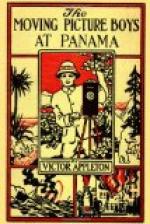He did not finish, but they knew what he meant. Slowly and irresistibly the great lock gates were closing and now the tug had almost been pulled back between them. She seemed likely to be crushed to splinters.
CHAPTER XIII
IN THE JUNGLE
“What will we do with the cameras, Blake? The films, too, they will all be spoiled—we haven’t enough waterproof cases!” cried Joe to his chum, as the boat, through some accident or failure, backed nearer and nearer to the closing steel gates.
“Will we really have to jump overboard?” asked the Spaniard. “I am not a very excellent swimmer.”
But Blake, at whom these questions seemed directed, did not have to answer them. For, after a series of confused shouts on the top of the concrete wall above them the movement of the boat, as well as the slow motion of the lock gates, ceased. It was just in time, for the rudder of the tug was not more than a few feet away from the jaws of steel.
“You’re all right now,” a man called down to those on the tug, from the wall over their heads. “Something went wrong with the towing locomotives. There’s no more danger.”
“Well, I’m glad to know that,” answered Captain Watson gruffly. “You might just as well kill a man as scare him to death. What was the matter, anyhow?”
“Well, all of our machinery isn’t working as smoothly as we’ll have it later,” the canal engineer explained. “Some of our signals went wrong as you were being towed through, and you went backward instead of forward. Then it took a minute or so to stop the lock gates. But you’re all right now, and you’ll go on through.”
Blake and Joe looked at each other and smiled in relief, and Mr. Alcando appeared to breathe easier. A little later the tug was again urged forward toward the front lock gates. Then the closing of those at her stern went on, until the vessel was in a square steel and concrete basin—or, rather, a rectangular one, for it was longer than it was wide, to lend itself to the shape of the vessels. As Blake had said, it was like a big swimming tank.
“Now we’ll go up,” Captain Watson said. “You can’t get any pictures in here, I suppose?” he added.
“We can show the water bubbling up as it fills the lock,” said Blake. “Water always makes a pretty scene in moving pictures, as it seems to move at just the right rate of speed. We’ll take a short strip of film, Joe, I guess.”
The tug did not occupy a whole section of the lock, for they are built to accommodate vessels a thousand feet long. To economize time in filling up such a great tank as that would be the locks are subdivided by gates into small tanks for small vessels.
“It takes just forty-six gates for all the locks,” explained Captain Watson, while Blake and Joe were getting their camera in position, and the men at the locks were closing certain water valves and opening others. “Each lock has two leaves, or gates, and their weight runs anywhere from three hundred to six hundred tons, according to its position. Some of the gates are forty-seven feet high, and others nearly twice that, and each leaf is sixty-five feet wide, and seven feet thick.”




